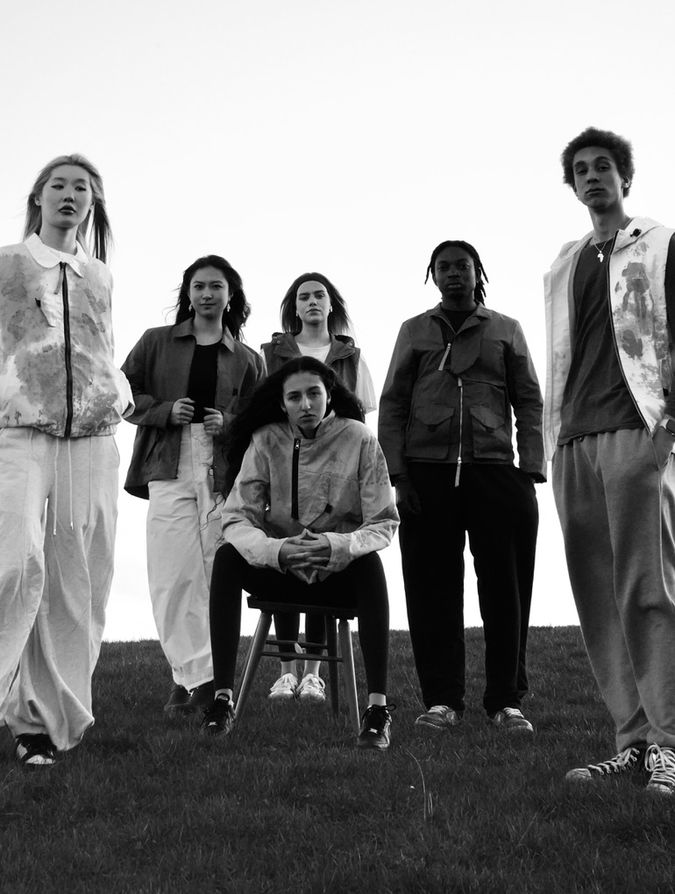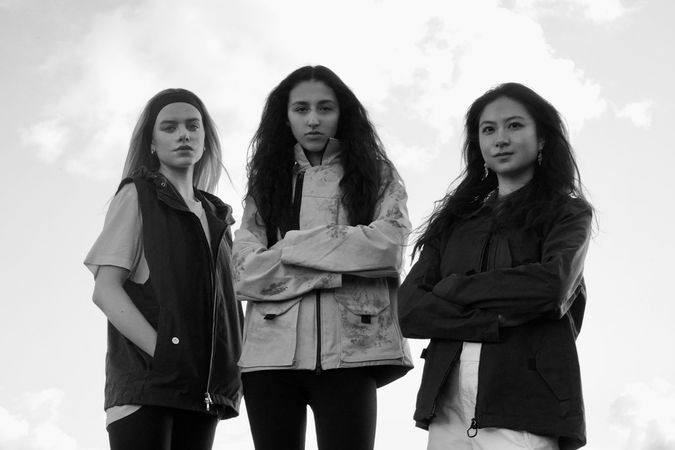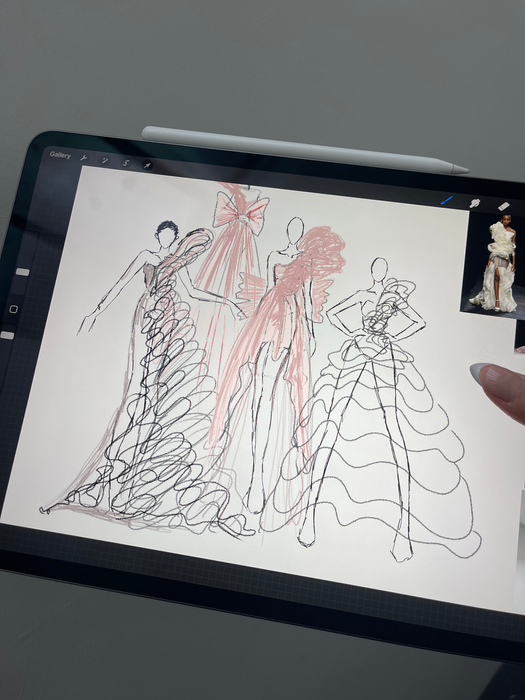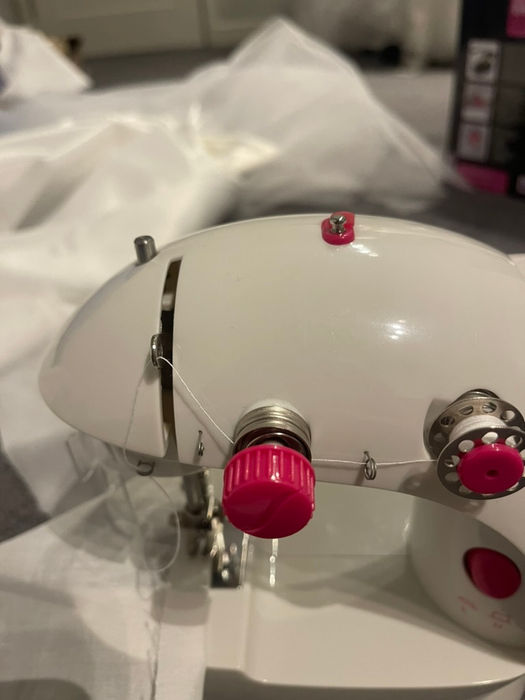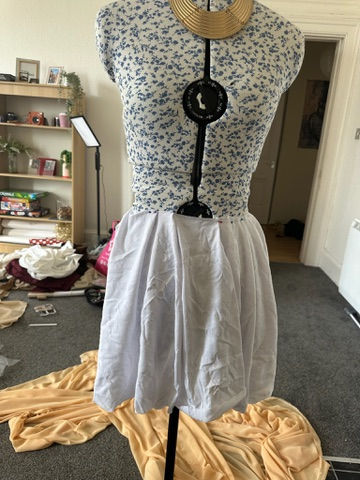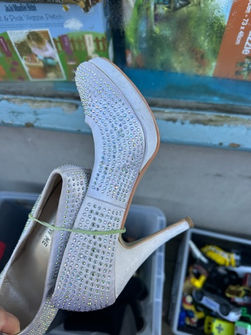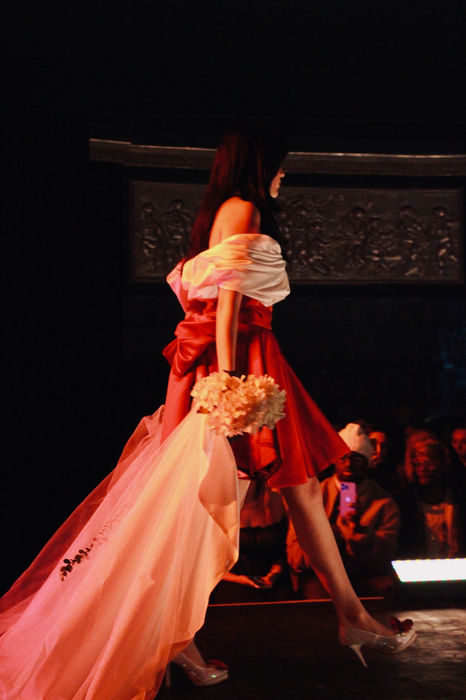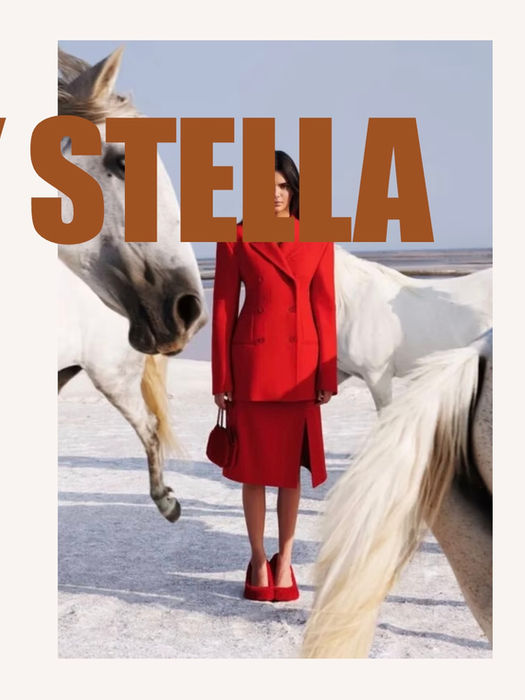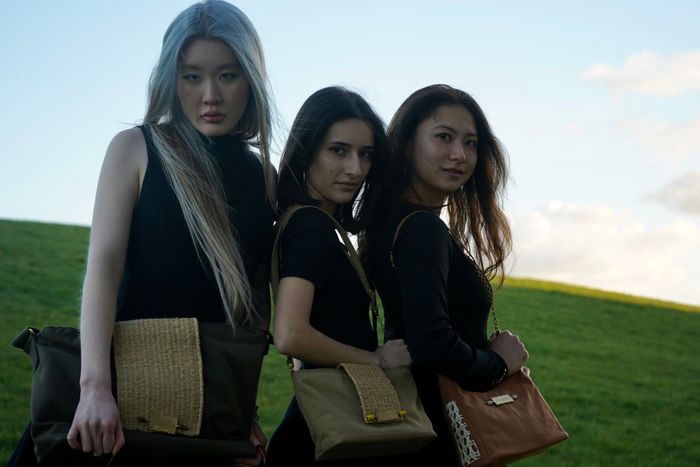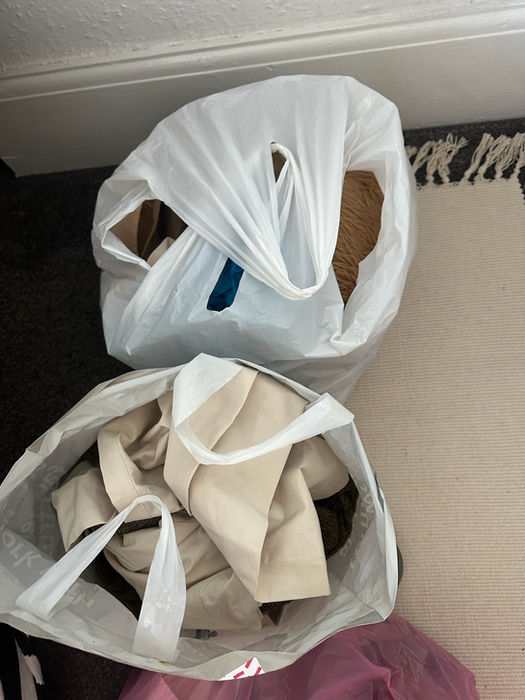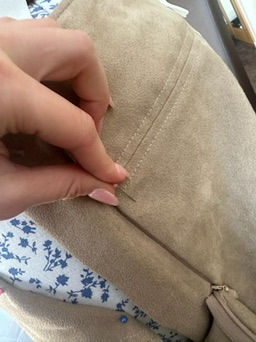A MEDIATED FASHION HYPOCRISY
EXPLORING INDIVIDUATION



Leila Bianco

WELCOME
A FASHION PORTFOLIO IN WHICH INDIVIDUATION IS EXPLORED.
This is a portfolio about contradictions, clothes, the self and the earth. A place of uttermost vulnerability and self-reflection.
LET ME INTRODUCE YOU TO THE
LINE
This line represents my inner divide between my conscious and unconscious, my unsustainable actions and sustainable actions, the duality and contradictions that will lead me to become whole - to discover the "self". Inspired by the scholar Karl Jung's theory of individuation, this line will guide you through the portfolio and represent a path that leads to individuation, a deeper understanding of my unconscious, in this project, more specifically, the relationship to the environment and fashion. Whilst exploring the hypocritical relationship between consuming and producing sustainable and non-sustainable products and services for the fashion industry, the portfolio aims to combine self-exploration with a showcase of professional work, as self-exploration in this period of my life is explicitly tied to my professional work. Through a series of media formats, an attempt will be made to uncover previously unknown elements of my inner duality, personal ethical struggle and imbalance between thinking and doing. The line is a path leading to my personal wholeness. The goal of the showcase is ultimately to represent relationship between the archetypal components of the psyche: the ego, persona, shadow and ultimately the self.
.png)
SECTION 1
THE EGO.
The ego is the center of the field of consciousness. As explained by Journal Psyche (2025) and Hopwood (2023), the ego is just a small part of the Self. Jung believed that consciousness is selective, meaning the ego picks out what feels most important from the environment and uses that to make decisions. Everything else that isn’t noticed or accepted slips into the unconscious. To me, this represents all the times I have chosen to do convenient projects, for the sake of social performance and general career success. It represents my "unsustainable self", the part of me that didn't think twice to take up an opportunity that contributes to our planet's environmental problems. In this section, I will present such work.
FELIDAE
One of my latest projects was directing a photoshoot for Felidae London, a "premium London fashion brand honed to comfort and quality" (Felidae, 2025), which connects wearers through creativity. The brand doesn't show any signs of incorporating sustainability at the forefront of their product lifecycle, as when I checked the clothing's material compositions the clothes primarily contained polyester, which according to Nguyen's (2023) full life-cycle analysis is the least sustainable material to be used for clothing, as it is produced with nonrenewable fossil resources in polluting and energy-intensive processes. When I took on this creative direction opportunity, I simply let my ego dictate what felt most important in my situation at the time, which was to gain experience for my portfolio. It did cross my mind that sustainability isn't a priority for this brand, yet I chose to support it and create content for it. I chose what seemed convenient for my experience.
WECANFLY
TILTED EAST

It was again the powerful message of Tilted East that attracted me to the brand, and inspired me to reach out to them for a collaboration. Tilted East was founded in a rehabilitation and recovery centre in South Africa in 2022 when the founders learned one of the huge challenges facing those affected by they mental health... they felt misunderstood. The brand allows people to communicate their feelings through design, their expression of mental health experiences. After creating the brand "people were given the ability to identify and relate with others on a deeper and more meaningful level - our experiences with this showed us just how healing being properly understood for the first time can be" (Tilted East, 2024). Even with this collaboration, I didn't prioritise sustainability, but instead collaborated with them because of their meaningful message. After checking the material compositions, the shirts were made of cotton. As noted by Nguyen (2023), the traditional way of cultivating cotton plants depends heavily on synthetic, toxic agrochemicals. Even if sustainability isn't at the forefront of the brand, my ego chose what seemed right in the moment.
TALES OF A TIME
For the 2024 Line Fashion show, which took place in Leamington Spa, I took on the role of Designer and designed a high-fashion piece based on the theme of Cinderella's "Fairy Godmother." This was the first moment that I could choose my materials and create my own sustainable design. Yet, at the time, I pureòy chose convenience. I went to a charity shop and bought the puffery build of the dress, not because I wanted to reuse existing materials, but because it was easier to design a new look on top of an already-made, long maxi skirt. I then purchased new materials, without checking the sustainability implications of the fabrics and created the design. I used 8 meters of duchess satin. Synthetic satin, "like polyester and acetate, uses chemicals derived from oil, wastes a lot of water, and pollutes the air (Birds of Babriclore, 2022). Even though part of the dress was recycled, since it was made from a previously worn maxi skirt, the intention behind my purchase was convenience. This, hence, doesn't make up for the lack of concern I had at the time for the product's life cycle. I was purely aiming for social praise and extravaganza with this design, and I achieved it. After the show, everyone congratulated me on even having "the best design at the fashion show." Yet, I achieved this with superficial intentions and an unsustainable choice of materials. As a designer in that moment, designing this dress was one of my proudest achievements, as days were invested into creating and building the design. Reflecting back on the experience, on the one hand, it's upsetting to think that I didn't organise my fabric selection time more efficiently to choose more sustainable alternatives. Yet, on the other hand, I remember how complicated the process was for me and the stress associated with finding good fabric options as a whole. Convenience was a safe spot for me at the time, and what was guiding the deeply meaningful experience of designing my first fashion piece. The design process is presented below.
ECHOES OF THE UNIVERSE: GLACIAL
In 2025, Line held another fashion show, for which I again applied to be Designer. The 2025 theme was "Echoes of the Universe", based on different realms of our planet, such as deserts, oceans, jungles etc. At this point in time, I had researched more on the topic of sustainable fashion, from basing my research topics around sustainable fashion for my BA Media and Creative Industries LP303 and LP302 modules, to basing my final year dissertation research for LP306 on sustainbility in luxury fashion, later solidfying it to "A Comparative Study of Sustainability Communication and Branding in Luxury Fashion and its Relationship with Consumer Self-Congruity and Social Influence." Hence, reminiscing on my mistakes from the Line 2024 Fashion Show, I decided this time I wanted to make the design sustainable and take into account all stages of the design process. I chose to challenge myself as a designer and create two high-fashion pieces instead of one: Glacial and Sand Storm. I wanted them both to be made of eco-friendly materials, or both to be recycled from scrap fabrics, destined for landfill. The good intention was there, yet I let the ego take over again and chose convenience for my second design, the Glacial realm. This time, planning ahead was present: I had sketched the design to use only scrap satin fabric from the Tales Of A Time 2024 design and planned out how much material I could use, adjusting my sketches as needed based on the available material. Nevertheless, when I started cutting the practice fabric (scrap material that I stitched together and couldn't use for anything else), I noticed my measurements were wrong. I took an unused plastic bag and tried redesigning the piece, but it didn't work. I didn't have enough satin fabric to complete my design. In that moment, my ego took over again, choosing convenience or what felt most important to me at the time. In that moment, finishing my design on time for the show was the priority. I could have redesigned my sketches to fit the actual available fabric, but I was running out of time. Instead, I went to the fabric store and bought new fabric needed for the build of the design. I felt very guilty, it was as if my design efforts had gone to waste, and my subconscious was shaming me. The process photos are presented below.
I ultimately used the white satin fabric from Line 2024, intended for the whole dress (pictured in the process photos), as a shoulder build-on. I also bought a pair of white shoes from a charity shop, which I later sewed bows on. I borrowed artificial flowers from a charity shop as well, and returned them after the show, alongside using scrap white fabric for the dress cape. These four aspects are the only ones I managed to accomplish sustainably. They are the reason this creative work is placed after the individuation line, as the work had a sustainable intention behind it, yet was still governed by the ego's sense of convenience at times.

SECTION 2
THE PERSONA HYPOCRISY.
The Journal Psyche (2025) and Hopwood (2023) explain that Karl Jung described the Persona as a part of the personality that forms for reasons of adaptation or personal convenience. It represents the different masks we wear in different situations, like the version of ourselves we show at work or with family. The Persona acts as the “public relations” side of the ego, helping us interact with others and move through social life more easily. In Jung's (1966: 216) words: "It is, as its name implies, only a mask of the collective psyche, a mask that feigns individuality, making others and oneself believe that one is individual, whereas one is simply acting a role through which the collective psyche speaks." This aspect brought me to reflect on my own masks, that I wear in different situations. To show the masks and their hypocritical existence, I present below two different versions of my creative portfolio: The Commercial Portfolio and The Sustainable Portfolio, mirroring my masks "the commercial creative" and "the sustainable creative". The portfolio's contain non-fashion related work as well, as I would use those to gain fashion industry experience.
The Commercial Portfolio and the Sustainable Portfolio represent my inner polarisation and personal hypocrisy. At times, I wear the mask of a sustainable fashion expert, who speaks to others about new innovations in the fashion industry, highlighting that sustainable materials are on the rise and can substitute for unsustainable ones. I take on opportunities that relate specifically to sustainability, as presented in the Sustainable Portfolio. Other times though, I wear the mask of the commercial creative, taking on all opportunities that have value in the market. Banet-Weiser (2020: 140) critiques the contemporary notion that “everyone can be” anything they aspire to be - whether an activist, creator, or producer - arguing that while this rhetoric suggests freedom and opportunity, it is deeply rooted in the logic of advanced capitalism. Through advertising, marketing, and digital platforms, consumers are encouraged to prioritize individualism, framing personal identity in ways that align with capitalist ideals. I found similar writings in Crary's (2013: 72) literature, where he describes "self-fashioning" (presenting oneself) as the work we are all given, and "dutifully comply with the prescription continually to reinvent ourselves and manage our intricate identities." Both of thier views made me reflect on and critique myself as a creative professional, capitalising on my creative talent and distributing my individualism and creativity in accordance with what the market seeks, continualy reinventing the masks I need to wear to feed what I would personally call a capitalist "machine." The work that is presented in the Commercial Portfolio represents this self-fashioning described by Crary, where certain experiences I pushed myself to do were not what I actually enjoyed doing, such as social media management experiences in the Content/Design Management section. They were instead a sort of reinvention of myself, representation of a creative who knwos how to operate that which the market seeks. I took on those opportunities because the skills I would gain from the job would allow me to capitalise on those skills.
Furthermore, the hypocrisy lies in my consumption choices, where I often choose convenience and buy from fast fashion brands like Zara. I try to buy clothing from small, local businesses that are transparent about their production and supply chains. However, such shops are often not near me when I need a specific piece of clothing. Those times, I choose convenience. The next section will explore this inner conflict in more detail.

SECTION 3
THE SHADOW.
Hopwood (2023) and Journal Psyche (2025) explain that the shadow holds all the parts of ourselves we don’t want to see, which would be the traits we dislike, deny, or find uncomfortable. It is a part of our personal unconscious, rooted in deeper collective patterns, and often shows qualities that are opposite to the ones we present through our persona. Jung (1966: 139) believed that instead of facing our shadow directly, we often project it onto others, meaning that the things we can’t stand in other people are often reflections of what we refuse to accept in ourselves. They explain that to truly grow, we must stop ignoring the shadow and work to balance it with our persona, making our personality more honest and whole. In this section, I explore the shadow, that which makes me uncomfortable to think about, alongside certain aspects of myself when relating to fashion, which I am not proud of.
In the following short film, I critique myself a bit more harshly, particularly in terms of my own fashion consumption choices and how I present my fashion style to others. I critique my part-time job and the overall human pursuit of happiness through capitalism. At the core of the short film, I aim to showcase my connection to nature, which ultimately fuels my interest in sustainable fashion, and the hypocrisy inherent in this connection. How can I balance wanting to live a happy lifestyle, full of material possessions that I desire, while "happiness" is taken away from nature? I am living my happy, colourfully clothed lifestyle, but at the expense of who, or what? We are ultimately all part of a complex, profit-based machine by dressing, eating, and living as we wish. It is as if we are unconscious participants in a system that profits from the global destruction which feeds these desires. And by global destruction I mean failing to meet the needs of the present without compromising the ability of future generations to meet their own needs - defined by the United Nations (1987) as sustainability. The repetition of the words dress, eat and live in the film presents the repetitive nature of the machine in which our identities are commodified, the machine that never seems to run out of energy, as it derives it from the earth.
Upon deep reflection while writing the short film script, I realised there's a distinction between the qualities I used to dislike in people and the ones I dislike currently, both of which are somewhat related to fashion as well. As of now, I cannot stand trend conformity, meaning people who are trend-dependent and seek approval. From a Jungian perspective, this would mean that as I project onto others a rejection of conformity, I might also subconsciously seek approval. Such a self-observation would actually make sense, as the qualities I used to dislike in people were the opposite: About a year ago or more, I would feel discomfort with eccentric fashion styles. I recall that I used to judge those who didn't conform to trends as much as I do. Hence, my shadow could have been a repression of self-expression and a fear of not belonging, as I disliked those who openly expressed themselves. This self-observation is very meaningful to me, as it would explain my current frustration with qualities I have never disliked before.

SECTION 4
THE SELF.
The Self, according to Jungian psychology, as Hopwood (2023) and Journal Psyche (2025) explain, is the totality of the psyche, including all of its potential. It is the organizing center behind the personality and it contains the drive toward fulfillment and wholeness. The Self drives the process of individuation, the lifelong journey toward becoming whole and reaching one’s fullest potential.
Unlike Freud, who saw the ego as the main center of the personality, Jung believed the ego is only one part that grows out of the much larger Self. Jung (1966: 238) quotes the connection between the Self and individuation: "Individuation means becoming an “in-dividual,” and, in so far as “individuality” embraces our innermost, last, and incomparable uniqueness, it also implies becoming one’s own self. We could therefore translate individuation as “coming to selfhood” or “self-realization.” In this final section, I present the creative works that I recall bringing me a feeling of peace and wholeness, a true sense of purpose - in a way, the opposite of what I would create, if I was to be fuelling the capitalist machine.
"QUALITY OVER QUANTITY"
The project "Quality Over Quantity" critiques modern capitalist society, by presenting an image of a sustainable design made by me, covered with embroidery and accompanied by the narration of late designer Vivienne Westwood - a notable figure in sustainable and timeless fashion design, who throughout her career has prioritised slow fashion over fast production in her business. Since the embroidery was done using white thread, I decided to include threads in the video. The distortion of the human face represents the public opinion that humans are victims of their own capitalistic actions, how they continue to self-destruct and harm the planet, if human overconsumption is not brought to a stop. My aim with this video was to visually showcase the handmade garment, while also engaging the observer in critical thinking. In the video, the two threads can be seen invading the artwork, just like humans invade natural habitats to serve our consumerist needs.
ZIIMARA
ZIIMARA London is an eco-friendly brand that produces bags made from repurposed materials. It is their mission that attracted me to collaborate with them. I creatively directed the campaign, styled the models and was in charge of photography. This was the first time I was able to create content for a sustainable brand, and I could feel a sense of peace after doing so.
ECHOES OF THE UNIVERSE: SAND STORM
In 2025, Line hosted the "Echoes of the Universe" Fashion Show. I chose to challenge myself as a designer and create two high-fashion pieces instead of one: Glacial and Sand Storm. As explained previously, I was unable to complete Glacial sustainably, letting my ego take over. Although I managed to complete the second design sustainably, Sand Storm. In the process pictures below, the whole upcycling process is presented, from material collection to end result. I first visited six charity shops and asked if I could take a look at their "rag" clothing - these are items that don't sell and are often collected in piles to be thrown away or recycled. I was shocked to see how many bags of "rag" there were in each charity shop. As I only needed beige clothing to complete my design, it was very challenging to find the right clothing. A lot of effort was put into sourcing the appropriate clothes, waiting for weeks at a time for the charity shop to collect beige items. I also asked all of the stores, if I could browse through the piles, but only one of them allowed me to do it (pictured in the first video). I then cut the pieces to create a new design. Stitching the rag leather skirt was particularly challenging, but it was the first time I created a designed made of repurposed materials. It was a moment of achievement for me as a sustainable creative.


STELLA MCCARTNEY CAMPAIGN VIDEO
A FINAL REFLECTION
While this project has allowed me to deepen my understanding of individuation, it also makes clear that the journey toward wholeness is ongoing. Integrating the contradictions within myself, between ego-driven choices and deeper values, is not a single event but a continual practice. True individuation means embracing these tensions honestly, without expecting perfection, and allowing creative practice to become a space of ongoing self-discovery.

















